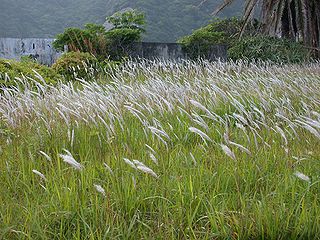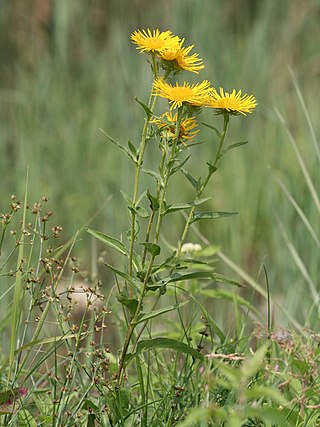
Imperata cylindrica is a species of perennial rhizomatous grass native to tropical and subtropical Asia, Micronesia, Melanesia, Australia, Africa, and Southern Europe. It has also been introduced to Latin America, the Caribbean, and the Southeastern United States. It is a highly flammable pyrophyte, and can spread rapidly by colonizing disturbed areas and encouraging more frequent wildfires.

The green iguana is the most globally traded reptile representing 46% of the total reptile trade in the US from 1996 and 2012, with annual imports reaching 1 million in 1996. In 1995, there were over 800,000 animals were imported into the United States alone, primarily originating from captive farming operations based in their native countries .The green iguana has also seen a surge of importation in the Greater Caribbean Region. A study done on invasive iguanas in Puerto Rico found that the sample population were mostly the product of populations originating from Columbia and El Salvador. Both countries contain several industrial-size pet iguana farming operations.

The richness and variety of the wildlife of Ethiopia is dictated by the great diversity of terrain with wide variations in climate, soils, natural vegetation and settlement patterns. Ethiopia contains a vast highland complex of mountains and dissected plateaus divided by the Great Rift Valley, which runs generally southwest to northeast and is surrounded by lowlands, steppes, or semi-desert.

Ctenosaura similis, commonly known as the black iguana or black spiny-tailed iguana, is an iguanid lizard native to Mexico and Central America. It has been reported in some Colombian islands in the Caribbean Sea and Pacific Ocean, and has been introduced to the United States in the state of Florida. The largest species in the genus Ctenosaura, it is commonly found in areas such as grasslands and forests.
There are a number of environmental issues in Florida. A large portion of Florida is a biologically diverse ecosystem, with large wetlands in the Everglades. Management of environmental issues related to the everglades and the larger coastal waters and wetlands have been important to the history of Florida and the development of multiple parts of the economy of Florida, including the influential agricultural industry. This biodiversity leaves much of Florida's ecological ecosystem vulnerable to invasive species and human sources of industrial pollution and waste.

Burmese pythons are native to Southeast Asia. However, since the end of the 20th century, they have become an established breeding population in South Florida. The earliest python sightings in Florida date back to the 1930s and although Burmese pythons were first sighted in Everglades National Park in the 1990s, they were not officially recognized as a reproducing population until 2000. Since then, the number of python sightings has exponentially increased with over 30,000 sightings from 2008 to 2010.

Pentanema britannica, the British yellowhead or meadow fleabane, is a Eurasian species of plant in the daisy family. It is widespread across much of Europe and Asia, and sparingly naturalized in scattered locations in North America.

Invasive species are a crucial threat to many native habitats and species of the United States and a significant cost to agriculture, forestry, and recreation. An invasive species refers to an organism that is not native to a specific region, this poses significant economic and environmental threats to its new habitat. The term "invasive species" can also refer to feral species or introduced diseases. Some introduced species, such as the dandelion, do not cause significant economic or ecologic damage and are not widely considered as invasive. Economic damages associated with invasive species' effects and control costs are estimated at $120 billion per year.
The Invasive Species Compendium (ISC) is an online, open access reference work covering recognition, biology, distribution, impact, and management of invasive plants and animals produced by CAB International alongside an international consortium. It comprises peer-reviewed datasheets, images, and maps, a bibliographic database, and full text articles. New datasheets, data sets, and scientific literature are added on a weekly basis. The ISC has been resourced by a diverse international consortium of government departments, non-governmental organizations, and private companies.

Garlic mustard was introduced to North America as a culinary herb in the 1860s and it is considered an invasive species in much of North America. As of 2020 it has been documented in most of the Eastern United States and Canada, with scattered populations in the west. It is listed as a noxious or restricted plant in the following states: Alabama, Connecticut, Massachusetts, Minnesota, New Hampshire, Oregon, Vermont, and Washington. A current map of its distribution in the United States can be found at the Early Detection and Distribution Mapping System (EDDmapS).
Invasive species are species that are native to foreign environments which may have important effects on a specific area's economy, ecosystem and infrastructure. These species can be introduced by natural causes or human intervention. There are many invasive species that exist around the world. One that is abundant around Puerto Rico is the lionfish. The United States Department of Agriculture (USDA)'s Animal and Plant Health Inspection Service (APHIS) Plant Protection and Quarantine (PPQ) and Customs and Border Protection (CBP) perform biosecurity inspections for Puerto Rico.

Florida hosts many types of fauna. From coral reefs of the Florida Keys to the cypress swamps of the Panhandle, the state's diverse habitats are home to a variety of wildlife. Florida is among the top five states in terms of endemic species. There are over 700 terrestrial animals, 200 freshwater fish species, 1,000 marine fish and thousands of terrestrial insects and other invertebrates that inhabit the state. Florida's peninsular geography spans from subtropical to tropical zones, which, combined with its distinctive geology and climate, contribute to habitat diversity and an array of species. The native wildlife that exists in the state are of temperate and tropical origin.

The Gau iguana is a species of iguana endemic to Gau Island in the Fijian archipelago. It mostly lives in the well-preserved upland forests of the island, with smaller populations in the degraded coastal forests. It can be distinguished from other South Pacific iguanas by the male's distinctive color pattern and solid green throat. It is also the smallest of all South Pacific iguanas, being about 13% smaller than the third smallest species and 40% smaller than the largest extant species.

Hymenachne amplexicaulis, also known as West Indian marsh grass in the US, Olive hymenachne in Australia, and hereafter referred to as hymenachne, is New World species in the genus Hymenachne. Hymenachne is from the Greek hymen meaning "membrane" and achne meaning "chaff, glume, scale" and amplexicaulis is from Latin, literally "embracing the stem" or "stem-clasping. This freshwater species is native to the tropical and subtropical regions of the West Indies, Northern South America, and Central America.

The Florida Python Challenge is an annual, ten-day competition where professional and novice participants join in the effort to remove invasive Burmese pythons in Florida. Past the goal of removing pythons, the competition also serves as a conservation effort to raise awareness about invasive species’ impacts to the local ecology and to encourage the public to continuously remove Burmese pythons from the wild. It is supported by the Florida Fish and Wildlife Conservation Commission (FWC), the Fish and Wildlife Foundation of Florida, the South Florida Water Management District (SFWMD), and Governor Ron DeSantis.












